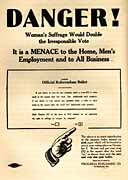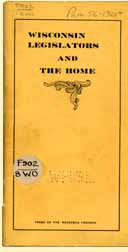

 |
 |
 Milwaukee June 1912 |
Both the Wisconsin Woman's Suffrage Association and the Political Equality League had office headquarters in Milwaukee. |
|
 Theodora Youmans |
My own first active suffrage work was that of press correspondent in that campaign. | |
 Milwaukee Sentinel Building 1911 |
Every week I sent out a suffrage letter to all the newspapers in the state, six hundred or more in number. I am still thrilled by the postage bills we had to pay every month. | |
 Dr. Shaw |
There is no adequate existing record of that campaign or even of its financial expenditures. The Political Equality League raised and expended $10,000, the amount permitted by the corrupt practices act. What sums were expended by other organizations I do not know. The National American Woman's Suffrage Association gave great assistance by paying the salary of a speaker and organizer, who did splendid service for many months. A mass meeting held in New York, arranged by Dr. Shaw and Crystal Eastman Benedict for the benefit of the Wisconsin campaign, netted $2,700. |
|
 |
Our belief concerning the determined hostility of the liquor interests was confirmed during the campaign of 1912 by the attitude of the magazine issued by the State Retail Liquor Dealers' Protective Association and appropriately called Progress. For weeks preceding the election the magazine was filled with argument and innuendo and abuse in prose and verse and picture, all designed to impress the reader with the absurdity and the danger of giving the vote to women. An unprecedentedly large vote was cast at the woman suffrage referendum at the election November 4, due partly, we flattered ourselves, to our efforts, and partly, we knew and did not flatter ourselves, to the efforts of our adversaries. The official count showed this result: For--135,736; against--227,054. Three constitutional amendments voted on at the same time received only slightly more than a fifth of the vote cast on the suffrage referendum. Of the seventy-one counties in the state fourteen carried for suffrage, Douglas County making the prize record with a plurality of 1,000. Milwaukee County, including Milwaukee city, gave 20,445 votes for and 40,029 against. |
|
 Mrs. Henry Youmans |
We rested a bit after that campaign. We needed it. But the rest was short. In January, 1913 a joint convention of the two suffrage organizations was called. Their hostility had been more than half friendly; they easily forgot their differences and buried the hatchet; and they united as one body under the old historic name, Wisconsin Woman's Suffrage Association. Mrs. Brown and Miss James both retired and a new president, vastly surprised to find herself in that position, was chosen. From that day to this, suffrage history in Wisconsin is very modern and many of us can say with the old chronicler, "All of this I saw, part of it I was." In looking back over the last seven years of the struggle there are some high lights; but mainly it is a sober record of doing the day's work as well as one could, educating and organizing, raising money and expending it, writing and exhorting, and never for one moment failing in faith as to the justice of our cause or its final outcome. |
|
 Suffrage Parade, Washington DC, March 3, 1913 |
The first year of my presidency we had no office and I took care of an extensive correspondence with my own pen. The next year an office was opened in Madison with an executive secretary in charge. Later the office was removed to Waukesha and in October, 1916, to Milwaukee, where in partnership with the Milwaukee County Suffrage Association, headquarters were continued until the dissolution of the organization. We held a suffrage school in Madison in 1914, the faculty including the chief justice of the supreme court of Wisconsin, members of the faculty of the University of Wisconsin, and many other well-known men and women. We went into the publishing business occasionally, although the great bulk of the enormous amount of literature distributed we purchased from the National American Woman Suffrage Association. Our own publications included Wisconsin Legislators and the Home, Social Forces, Wisconsin Legislation--Topics for Discussion, and various timely leaflets. For many years one of our devoted members, Mrs. Hannah Patchin, donated the money for prizes for an essay contest on woman suffrage among school children, thus promoting interest and knowledge of this movement among citizens of the future. |
 (Read from it!) |
 Suffrage School |
||
 Wisconsin Suffragists |
We sent an imposing contingent to the suffrage parade in Chicago in June, 1916, when the suffrage hosts marching down Michigan Avenue in a downpour of rain and gale of wind testified to their heartfelt desire for the ballot, in presence of the delegates to the national Republican convention there looking on--at least we ardently desired them to be looking on. Outside of Illinois, Wisconsin had the largest delegation, each member wearing a yellow Wisconsin tunic and the contingent being escorted by a G. A. R. drum corps. |
|